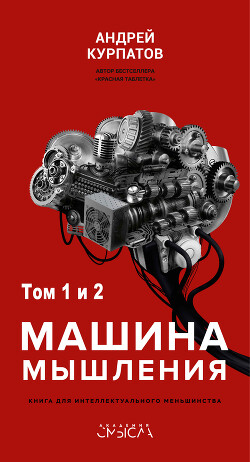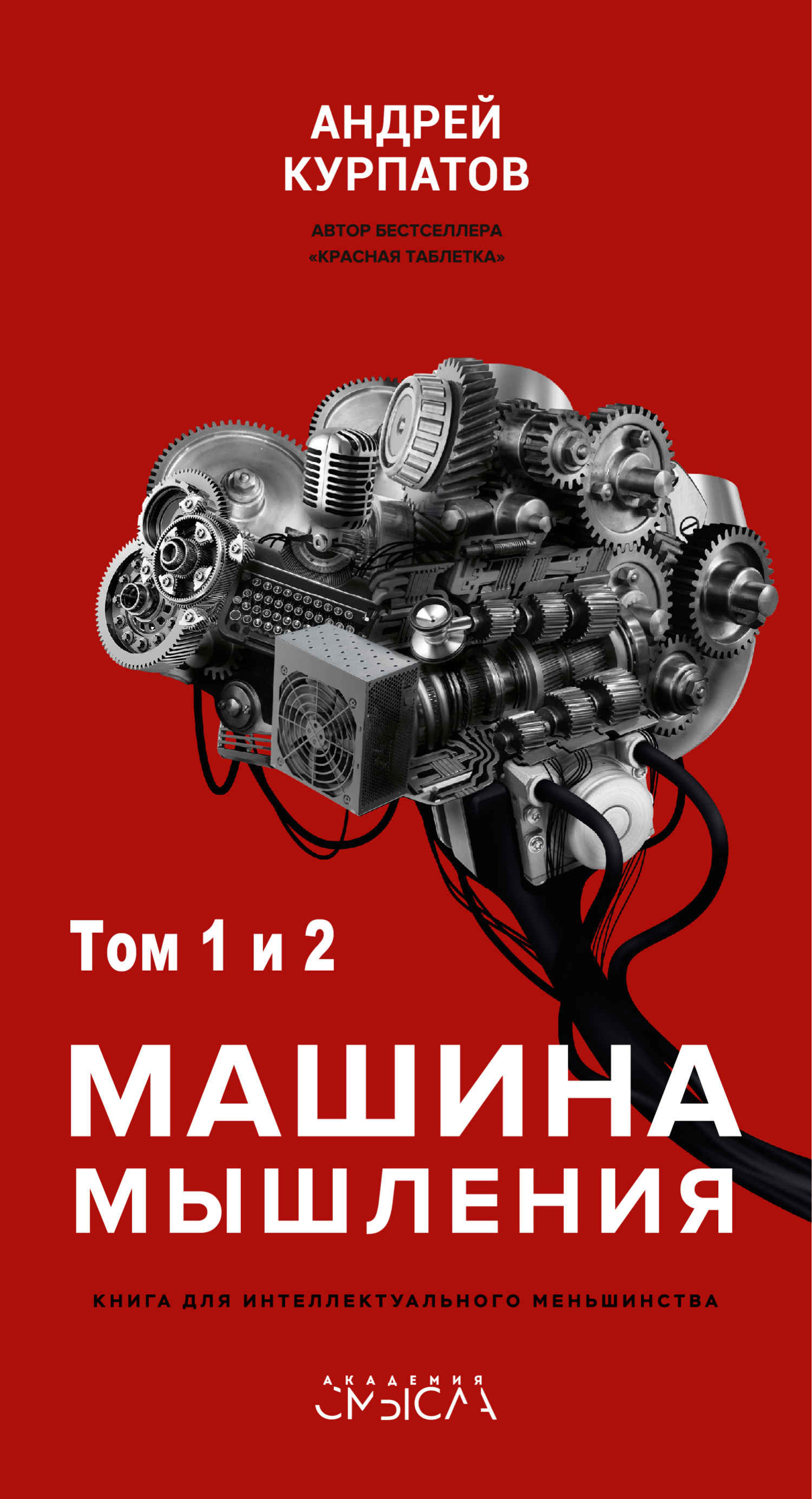Машина мышления. Заставь себя думать - Курпатов Андрей Владимирович

Помощь проекту
Машина мышления. Заставь себя думать читать книгу онлайн
38 Ruben C. Gur, Bruce I. Turetsky, Mie Matsui, Michelle Yan, Warren Bilker, Paul Hughett and Raquel E. Gur Sex Differences in Brain Gray and White Matter. In: Healthy Young Adults: Correlations with Cognitive Performance // Journal of Neuroscience, 1999. 19(10). P. 4065–4072.
39 Madhura Ingalhalikar, Alex Smith, Drew Parker, Theodore D. Satterthwaite, Mark A. Elliott, Kosha Ruparel, Hakon Hakonarson, Raquel E. Gur, Ruben C. Gur, and Ragini Verm. Sex differences in the structural connectome of the human brain // PNAS. 2014. V 111. № 2. P. 823–828.
40 Дэвидсон P., Бэгли Ш. Эмоциональная жизнь мозга. СПб.: Питер, 2017. С. 43–44.
41 Annukka К. Lindell Continuities in emotion lateralization in human and non-human primates // Frontiers Human Neuroscience, 2013.
42 Borod J. C. (1993). Emotion and the brain – anatomy and theory: An introduction to the Special Section // Neuropsychology. 7. P. 427–432; Дэвидсон, P, Бэгли Ш. Эмоциональная жизнь мозга. С. 44.
43 Alan Parkin. Explorations in Cognitive Neuropsychology // Psychology Press. 1st Edition. 1999. 296 p.
44 Wolman David. The Split Brain: A Tale of Two Halves // Nature. 2012. 483. P. 260–263.
45 Юм Д. Соч.: в 2 т. М.: Мысль, 1996. Т. 1. С. 298–299.
46 Веккер Л.М. Психика и реальность: единая теория психических процессов. М.: Смысл, 1998. 670 с.
47 Давид Юм. Соч.: в 2 т. Т. 2. С. 16, 19–20.
48 Corballis МС (2014) Left Brain, Right Brain: Facts and Fantasies. PLoS Biol 12(1). P. el001767.
49 Rizzolatti G, Arbib M.A. Language within our grasp // Trends in Neuroscitnce. 1998. 21(5). P. 188–194.
50 Brancucci A., Lucci G., Mazzatenta A., Tommasi L. Asymmetries of the human social brain in the visual, auditory and chemical modalities // Philosophical Transactions of The Royal Society В Biological Sciences, 2009. 364(1519). P. 895–914.
51 David S. Grayson, Siddharth Ray, Samuel Carpenter, Swathi Iyer, Taciana G. Costa Dias, Corinne Stevens, Joel T. Nigg, Damien A. Fair Structural and Functional Rich Club Organization of the Brain in Children and Adults // Pios One. 2014.
52 Bever T.G., Chiarello RJ. Cerebral Dominance in Musicians and Nonmusicians // The Journal of Neuropsychiatry and Clinical Neurosciences. 2009. 21. P. 94–97.
53 Marzi C.A., Berlucchi G. Right visual field superiority for accuracy of recognition of famous faces in normal // Neuropsychologia. Vol. 15. Issue 6. 1977. P. 751–756.
54 Martin A. Automatic activation of the medial temporal lobe during encoding: Lateralized influences of meaning and novelty // Hippocampus, 1999. 9(1). P. 62–70.
55 Голдберг Э. Управляющий мозг: лобные доли, лидерство и цивилизация. М.: Смысл, 2003. 335 с.
56 Gold J. М. et al. PET validation of a novel prefrontal task: Delayed response alteration // Neuropsychology. 1996. Vol. 10. P. 3–10.
57 Davidson, RJ. Parsing affective space: Perspectives from neuropsychology and psychophysiology. Neuropsychology. 1993. 7(4). P. 464–475.
Глава 8
Калейдоскоп мышления
58 Gazzaniga Michael S. Social Brain: Discovering the Networks of the Mind (англ.). Basic Books, 1987.
59 Nummenmaa L., HirvonenJ., Parkkola R., Hietanen J.K. Is emotional contagion special? An fMRI study on neural systems for affective and cognitive empathy // Neuroimage. 43 (2008). P. 571–580.
60 Duarte I.C., Afonso S., Jorge H., Cayolla R., Ferreira C., Castelo-Branco M. Tribal love: the neural correlates of passionate engagement in football fans // Social Cognitive and Affective Neuroscience. 12 (2017). P. 718–728.
61 Ahmed E.I., Zehr J.L., Schulz K.M., Lorenz B.H., Don-Carlos L.L. & Sisk C.L. Pubertal hormones modulate the addition of new cells to sexually dimorphic brain regions // Nature Neuroscience. 2008. Vol. 11. P. 995–997.
62 Takashi Yamaguchi, Dongyu Wei, Soomin C. Song, Byungkook Lim, Nicolas X. Tritsch, Dayu Lin. Posterior amygdala regulates sexual and aggressive behaviors in male mice // Nature Neuroscience. 2020. Vol. 23. P. 1111–1124.
63 Swaab D.E, Wolff S.E.C., Bao A.-M. Sexual differentiation of the human hypothalamus: Relationship to gender identity and sexual orientation // Handb Clin Neurol. 2021.181. P. 427–443.
64 Perry B.D. Childhood experience and the expression of genetic potential: What childhood neglect tells us about nature and nurture // Brain & Mind, 2002. 3(1). P. 79–100.
65 Perry B.D. & Pollard R. Altered brain development following global neglect in early childhood // Proceedings from the Annual Meeting of the Society for Neuroscience. New Orleans. 1997.
66 Барт P. Фрагменты речи влюбленного ⁄ М.: Ad Marginem, 1999.
67 Фуко М. Воля к знанию. История сексуальности. Т. 1. М.: Касталь, 1996. 448 с.; Фуко М. Использование удовольствий. История сексуальности. Т. 2 ⁄ Пер. с фр. В. Каплуна. [СПб.]: Академический проект, 2004. 432 с.; Фуко М. Забота о себе. История сексуальности. Т. 3. Киев: Дух и Литера, 1998; Фуко М. Признания плоти. История сексуальности. Т. 4 ⁄ Пер. с фр. С. Гашков. Ад Маргинем Пресс, 2021.
68 Курпатов А.В., Аверьянов Г.Г., Полетаева О.О. Суицид и суицидальный дискурс //V Клинические павловские чтения: сб. работ. Вып. 5. Кризисные состояния. Суицидальное поведение ⁄ Под общ. ред. А.В. Курпатова. СПб.: Человек, 2002. С. 28–35.
69 Wolfram Schultz, Leon Tremblay, Jeffrey R. Hollerman. Reward Processing in Primate Orbitofrontal Cortex and Basal Ganglia // Cerebral Cortex, 2000. Vol. 10. Issue 3. P. 272–283.
70 Барт P. Фрагменты речи влюбленного. С. 415–416.
71 Фуко М. Воля к истине: по ту сторону знания, власти и сексуальности. Работы разных лет ⁄ Пер. с франц. М.: Касталь, 1996. С. 436–437.
72 Там же. С. 434.
73 Loftus Е.Е, Palmer J.С. Reconstruction of automobile destruction: An example of the interaction between language and memory // Journal of Verbal Learning and Verbal Behavior. 1974. 13(5). P. 585–589.
74 Addis D.R., Pan L., Vu M.A., Laiser N., Schacter D.L. Constructive episodic simulation of the future and the past: distinct subsystems of a core brain network mediate imagining and remembering // Neuropsychologia. 2009. 47. P. 2222–2238.
75 R.P. Roberts, K. Wiebels, R.L. Sumner, V. van Mulukom, C.L. Grady, D.L. Schacter, D.R. Addis An fMRI investigation of the relationship between future imagination and cognitive flexibility // Neuropsychologia. 2017. 27. 95. P. 156–172.
76 D.H. Ingvar. «Memory of the future»: an essay on the temporal organization of conscious awareness // Human Neurobiology. 1985. 4(3). P. 127–136.
77 Suddendorf T. The Rise of the Metamind. 1997. In: M.C. Corballis, S.E.G. Lea (Eds.). The Descent of Mind: Psychological Perspectives on Hominid Evolution // Oxford University Press. P. 218–260.
78 Karl K. Szpunar, Jason M. Watson, and Kathleen B. McDermott. Neural substrates of envisioning the future // Proceedings of the National Academy of Sciences. 2007. 104(2). P 642–647.
79 Daniel L. Schacter, Donna Rose Addis. The cognitive neuroscience of constructive memory: remembering the past and imagining the future // Philosophical Transactions of the Royal Society of London. Series B. Biological Sciences. 2007. 362(1481). P. 773–786.
80 Daniel L.Schacter, Donna Rose Addis, Demis Hassabis, Victoria C.Martin, R. Nathan Spreng, Karl K.Szpunar. The Future of Memory: Remembering, Imagining, and the Brain // Neuron. 2012. Vol. 76. Issue 4. P. 677–694.
81 Meyer M.L., Hershfield H.E., Waytz A.G., Mildner J.N., & Tamir D.L Creative expertise is associated with transcending the here and now // Journal of Personality and Social Psychology. 2019. 116(4). P 483–494.

























